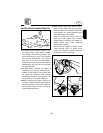
E
In other words, follow the standard rules
except when a collision will occur unless
both vessels try to avoid each other. If
that is the case, both vessels become
“Give-Way” vessels.
RULES WHEN ENCOUNTERING
VESSELS
There are three main situations which you
may encounter with other vessels which
could lead to a collision unless the Steer-
ing Rules are followed:
Meeting (you are approaching another
vessel head-on)
Crossing (you are traveling across the
other vessel’s path)
Overtaking (you are passing or being
passed by another vessel)
In the following illustration, your water
vehicle is in the center. You should give
the right-of-way to any vessels shown in
the white area (you are the Give-Way ves-
sel). Any vessels in the shaded area must
yield to you (they are the Give-Way ves-
sels). Both you and the meeting vessel
must alter course to avoid each other.
1-14
Meeting
If you are meeting another power vessel
head on, and are close enough to run the
risk of collision, neither of you has the
right-of-way! Both of you should alter
course to avoid an accident. You should
keep the other vessel on your port (left)
side. This rule doesn’t apply if both of you
will clear one another if you continue on
your set course and speed.
Crossing
When two power driven vessels are
crossing each other’s path close enough
to run the risk of collision, the vessel
which has the other on the starboard
(right) side must keep out of the way of
the other. If the other vessel is on your
right, you must keep out of its way; you
are the Give-Way vessel. If the other ves-
sel is on your port (left) side, remember
that you should maintain course and
direction, provided the other vessel gives
you the right-of-way as it should.
KA031
KA032
STAND-ON VESSEL
GIVE-WAY VESSEL
KA033


















